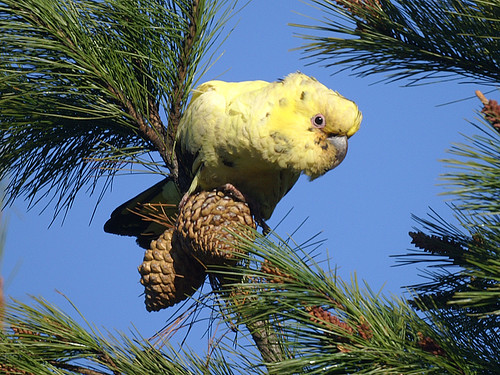Birds of a feather flock to a luminous leader
 Saturday, December 27, 2008 at 13:00
Saturday, December 27, 2008 at 13:00  Mutation Yellow-tailed black cockatoo. Image by David CookIt's the colour of hope, humility and the Beatles' mythic submarine. But yellow is usually confined to just a flash of cheek and tail plumage for the average yellow-tailed black cockatoo.
Mutation Yellow-tailed black cockatoo. Image by David CookIt's the colour of hope, humility and the Beatles' mythic submarine. But yellow is usually confined to just a flash of cheek and tail plumage for the average yellow-tailed black cockatoo.
This rare yellow-hued version of Australia's biggest cockatoo (Calyptorhynchus funereus) flew into Canberra's southern suburbs on Christmas Day, where it was photographed by Narrabundah resident Lorraine Mulholland.
''Our family was enjoying the last light of Christmas Day when we heard a small mob of yellow-tailed black cockatoos sweep into the trees that line Hindmarsh Drive alongside our townhouse in Leahy Close.
''We went out on our balcony to see them, when we spotted this beauty almost completely yellow, apart from some black flecks in his body feathers and some black feathers in the underside of his tail,'' she said.
One of Australia's leading cockatoo experts, Denis Saunders, said the yellow plumage was a genetic aberration that was ''rare but not uncommon''.
The yellow cockatoos were usually accepted by the rest of the flock and the only factor that tended to preclude a long, happy life on the wing was their visibility to predators.
''That's their big disadvantage. There's no reason why a bird like this couldn't breed, but its colouring would make it easy for a bird of prey like a wedge-tailed eagle to pick it off.''
But there appears to be some confusion about the correct term for this unusual coloured plumage.
A yellow-hued sulphur crested cockatoo spotted just a few months ago in Sydney's northern suburbs has been described by the NSW parks service as '' a lutino'' a term used by bird breeders to describe yellow budgerigars.
Canberra Ornithologists Group president, Chris Davey said the unusual colouring was caused by the black skin pigment melanin ''not doing what it's supposed to do'' and colour-aberrant birds are usually referred to as ''melanistic''.
''We had a flock of ravens in Canberra for a while that had white wings. It's just one of those things that can happen with birds,'' he said.
A local landcare blog has been tracking a ''luminous yellow version of a yellow-tailed black cockatoo'' near Bungendore, and uses the term ''leucism'' to describe the reduced pigmentation.
Ms Mulholland said the yellow bird was ''the first to arrive and seemed to be the leader''.
It seems there could be a colour-coded reason for this, with the cockatoo literally providing a ''glowing'' example of avian leadership.
Cockatoos can see a greater spectrum of colours including ultra-violet light than the human eye, and yellow feathers have been shown to glow or turn fluorescent in certain light.

